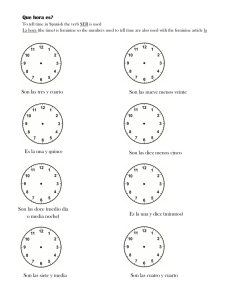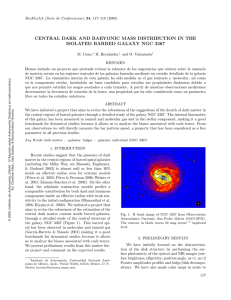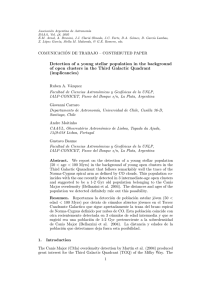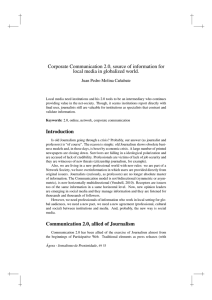DO THE VARIOUS TYPES OF PNE KNOTS DIFFER IN TERMS OF
Anuncio
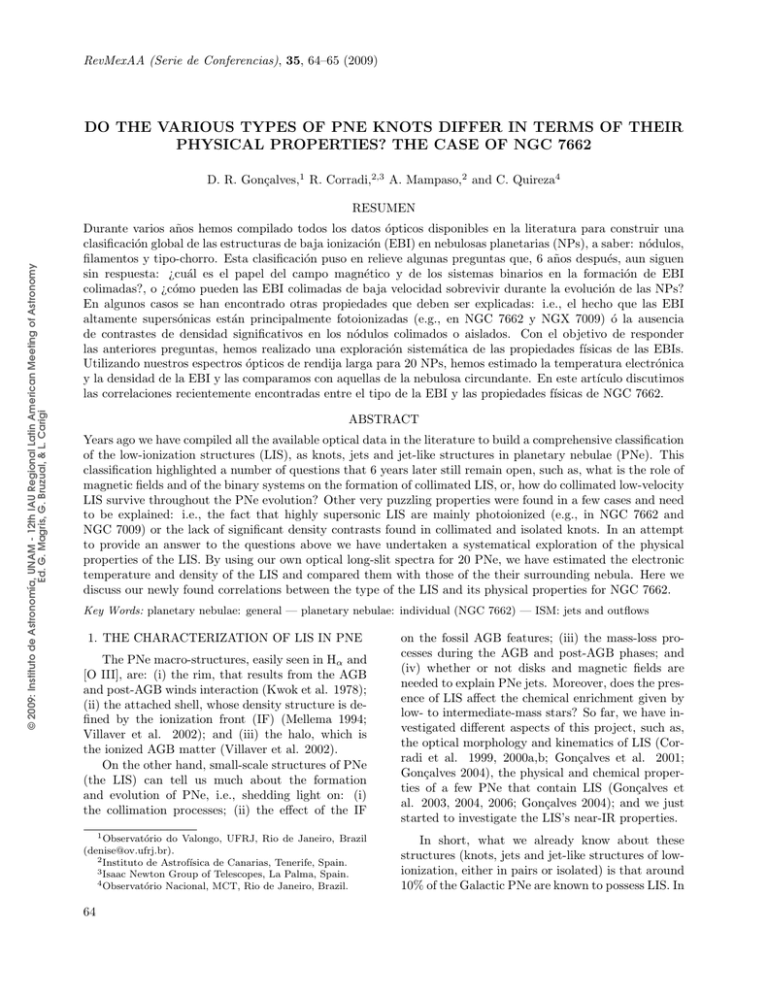
RevMexAA (Serie de Conferencias), 35, 64–65 (2009) DO THE VARIOUS TYPES OF PNE KNOTS DIFFER IN TERMS OF THEIR PHYSICAL PROPERTIES? THE CASE OF NGC 7662 D. R. Gonçalves,1 R. Corradi,2,3 A. Mampaso,2 and C. Quireza4 © 2009: Instituto de Astronomía, UNAM - 12th IAU Regional Latin American Meeting of Astronomy Ed. G. Magris, G. Bruzual, & L. Carigi RESUMEN Durante varios años hemos compilado todos los datos ópticos disponibles en la literatura para construir una clasificación global de las estructuras de baja ionización (EBI) en nebulosas planetarias (NPs), a saber: nódulos, filamentos y tipo-chorro. Esta clasificación puso en relieve algunas preguntas que, 6 años después, aun siguen sin respuesta: ¿cuál es el papel del campo magnético y de los sistemas binarios en la formación de EBI colimadas?, o ¿cómo pueden las EBI colimadas de baja velocidad sobrevivir durante la evolución de las NPs? En algunos casos se han encontrado otras propiedades que deben ser explicadas: i.e., el hecho que las EBI altamente supersónicas están principalmente fotoionizadas (e.g., en NGC 7662 y NGX 7009) ó la ausencia de contrastes de densidad significativos en los nódulos colimados o aislados. Con el objetivo de responder las anteriores preguntas, hemos realizado una exploración sistemática de las propiedades fı́sicas de las EBIs. Utilizando nuestros espectros ópticos de rendija larga para 20 NPs, hemos estimado la temperatura electrónica y la densidad de la EBI y las comparamos con aquellas de la nebulosa circundante. En este artı́culo discutimos las correlaciones recientemente encontradas entre el tipo de la EBI y las propiedades fı́sicas de NGC 7662. ABSTRACT Years ago we have compiled all the available optical data in the literature to build a comprehensive classification of the low-ionization structures (LIS), as knots, jets and jet-like structures in planetary nebulae (PNe). This classification highlighted a number of questions that 6 years later still remain open, such as, what is the role of magnetic fields and of the binary systems on the formation of collimated LIS, or, how do collimated low-velocity LIS survive throughout the PNe evolution? Other very puzzling properties were found in a few cases and need to be explained: i.e., the fact that highly supersonic LIS are mainly photoionized (e.g., in NGC 7662 and NGC 7009) or the lack of significant density contrasts found in collimated and isolated knots. In an attempt to provide an answer to the questions above we have undertaken a systematical exploration of the physical properties of the LIS. By using our own optical long-slit spectra for 20 PNe, we have estimated the electronic temperature and density of the LIS and compared them with those of the their surrounding nebula. Here we discuss our newly found correlations between the type of the LIS and its physical properties for NGC 7662. Key Words: planetary nebulae: general — planetary nebulae: individual (NGC 7662) — ISM: jets and outflows 1. THE CHARACTERIZATION OF LIS IN PNE The PNe macro-structures, easily seen in Hα and [O III], are: (i) the rim, that results from the AGB and post-AGB winds interaction (Kwok et al. 1978); (ii) the attached shell, whose density structure is defined by the ionization front (IF) (Mellema 1994; Villaver et al. 2002); and (iii) the halo, which is the ionized AGB matter (Villaver et al. 2002). On the other hand, small-scale structures of PNe (the LIS) can tell us much about the formation and evolution of PNe, i.e., shedding light on: (i) the collimation processes; (ii) the effect of the IF 1 Observatório do Valongo, UFRJ, Rio de Janeiro, Brazil ([email protected]). 2 Instituto de Astrofı́sica de Canarias, Tenerife, Spain. 3 Isaac Newton Group of Telescopes, La Palma, Spain. 4 Observatório Nacional, MCT, Rio de Janeiro, Brazil. 64 on the fossil AGB features; (iii) the mass-loss processes during the AGB and post-AGB phases; and (iv) whether or not disks and magnetic fields are needed to explain PNe jets. Moreover, does the presence of LIS affect the chemical enrichment given by low- to intermediate-mass stars? So far, we have investigated different aspects of this project, such as, the optical morphology and kinematics of LIS (Corradi et al. 1999, 2000a,b; Gonçalves et al. 2001; Gonçalves 2004), the physical and chemical properties of a few PNe that contain LIS (Gonçalves et al. 2003, 2004, 2006; Gonçalves 2004); and we just started to investigate the LIS’s near-IR properties. In short, what we already know about these structures (knots, jets and jet-like structures of lowionization, either in pairs or isolated) is that around 10% of the Galactic PNe are known to possess LIS. In © 2009: Instituto de Astronomía, UNAM - 12th IAU Regional Latin American Meeting of Astronomy Ed. G. Magris, G. Bruzual, & L. Carigi PHYSICAL PROPERTIES OF PNE KNOTS: NGC 7662 Fig. 1. NGC 7662, an example of PNe with low-velocity SLOWERs, PA=248◦ ) and high-velocity (FLIERs, PA=175◦ ) pairs of knots. Within the boxes the Ne [S II] (upper) and Ne [Cl III] (lower) values of each feature are given. This figure was adapted from Figure 1 of Perinotto et al. (2004). addition: (i) they are indistinctly spread among all the PNe morphological classes; (ii) 50% of these PNe have highly collimated, high-velocity jets, and/or high-velocity pairs of knots (FLIERs); (iii) most of them are mainly photoionized (Gonçalves et al. 2001; Gonçalves 2004). 2. THIS SURVEY: SAMPLE AND RESULTS This survey is based on long-slit optical spectroscopy of medium resolution, taken at the 2.5 m INT, with ∆λ = 3650 − 7000 Å, a reciprocal dispersion of 3.11 Å per pixel, and a spatial resolution of 0.7000 per pixel. Diagnostic emission line ratios we adopt for this analysis –roughly representing the low- as well as high-ionization regions within a typical PN– are: • Ne [S II] ∝ I(6717Å)/I(6737Å); • Ne [Cl III] ∝ I(5517Å)/I(5537Å); • Te [O III] ∝ I(4959Å+5007Å)/I(4363Å); • Te [N II] ∝ I(6548Å+6583Å)/I(5755Å); • Te [S II] ∝ I(6717Å+6737Å)/I(4069Å+4076Å). In Figure 1 (NGC 7662) we show LIS that share the expansion of the rim and shells, SLOWERs (position angle, PA=248◦ ) as well as the highly supersonic FLIERs (PA=175◦ ). The symmetrical (inner and outer) pairs of FLIERs do not differ 65 from each other in terms of Ne , but at a given region of the nebula (Northern or Southern) the inner FLIERs are at least a factor of 2 denser than the outer. Rim densities differ significantly from those of both pairs of FLIERs. The pair of SLOWERs, on the other hand, have similar densities, that are also very similar to the Ne of the rim. Temperatures are constant throughout the PN in both PA: Te [O III]=13,500 K and Te [N II]=12,200 K, for PA=175◦ ; and Te [O III]=12,950 K and Te [N II]=10,950 K, for PA=248◦ . From these figures, what we conclude is that high-velocity (highly supersonic, FLIERs) knots do not differ from lowvelocity (SLOWERs) knots either in terms of Te or Ne . FLIERs located at the Northern or Southern portions of the nebula are more easily differentiated from each other than FLIERs and SLOWERs. Moreover, following the detailed analysis of the same LIS, by Perinotto et al. (2004), the main excitation mechanism of FLIERs and SLOWERs is also the same, namely photoionization. These results are at variance with the expected shock excitation of the highly supersonic features, and with the fact that long-lived, well collimated structures should be denser than their surrounds, that is the opposite of what we got for NGC 7662. REFERENCES Corradi, R. L. M., Gonçalves, D. R., Villaver, E., Mampaso, A., & Perinotto, M. 2000a, ApJ, 542, 861 Corradi, R. L. M., Gonçalves, D. R., Villaver, E., Mampaso, A., Perinotto, M., Schwarz, H. E., & Zanin, C. 2000b, ApJ, 535, 823 Corradi, R. L. M., Perinotto, M., Villaver, E., Mampaso, A., & Gonçalves, D. R. 1999, ApJ, 523, 721 Gonçalves, D. R. 2004, in ASP Conf. Ser. 313, Asymmetrical Planetary Nebulae III: Winds, Structure and the Thunderbird, ed. M. Meixner, J. Kastner, & B. Balick (San Francisco: ASP), 216 Gonçalves, D. R., Corradi, R. L. M., & Mampaso, A. 2001, ApJ, 547, 302 Gonçalves, D. R., Corradi, R. L. M., Mampaso, A., & Perinotto, M. 2003, ApJ, 597, 975 Gonçalves, D. R., Ercolano, B., Carnero, A., Mampaso, A., & Corradi, R. L. M. 2006, MNRAS, 365, 1039 Gonçalves, D. R., Mampaso, A., Corradi, R. L. M., Perinotto, M., Riera, A., & Lṕez-Martı́n, L. 2004, MNRAS, 355, 37 Kwok, S., Purton, C. R., & Fitzgerald, P. M. 1978 ApJ, 219, L125 Mellema, G. 1994, A&A, 290, 915 Perinotto, M., Patriarchi, P., Balick, B., & Corradi, R. L. M. 2004, A&A, 422, 963 Villaver, E., Manchado, A., & Garcı́a-Segura, G. 2002, ApJ, 581, 1204

